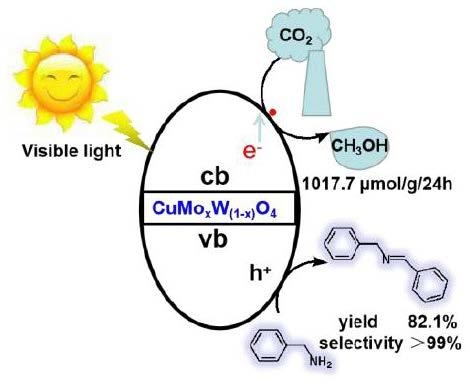CuMoxW(1-x)O4 Solid Solution Display Visible Light Photoreduction of CO2 to CH3OH Coupling with Oxidation of Amine to Imine
Abstract
1. Introduction
2. Experimental
2.1. General
2.2. The Preparation of Solid Solution Photocatalysts
2.3. Photocatalytic Reduction of CO2
3. Results and Discussion
3.1. Catalyst Characterization
3.1.1. XRD and EDX Analysis
3.1.2. SEM and TEM Analysis
3.1.3. UV-Vis Absorption and PL Spectroscopy Analysis
3.2. Photocatalytic Reduction of Carbon Dioxide Activity Measurement
4. Conclusions
Supplementary Materials
Author Contributions
Funding
Conflicts of Interest
References
- Li, D.; Rohani, V.; Fabry, F.; Parakkulam Ramaswamy, A. Direct conversion of CO2 and CH4 into liquid chemicals by plasma-catalysis. Appl. Catal. B Environ. 2020, 261, 118228. [Google Scholar] [CrossRef]
- Wang, Y.; Gao, W.; Kazumi, S.; Li, H.; Yang, G.; Tsubaki, N. Direct and Oriented Conversion of CO2 into Value-Added Aromatics. Chemistry 2019, 25, 5149–5153. [Google Scholar] [CrossRef]
- Zheng, Y.; Vasileff, A.; Zhou, X.; Jiao, Y.; Jaroniec, M.; Qiao, S.-Z. Understanding the Roadmap for Electrochemical Reduction of CO2 to Multi-Carbon Oxygenates and Hydrocarbons on Copper-Based Catalysts. J. Am. Chem. Soc. 2019, 141, 7646–7659. [Google Scholar] [CrossRef]
- Ma, J.; Sun, N.; Zhang, X.; Zhao, N.; Xiao, F.; Wei, W.; Sun, Y. A short review of catalysis for CO2 conversion. Catal. Today 2009, 148, 221–231. [Google Scholar] [CrossRef]
- Hu, B.; Guild, C.; Suib, S.L. Thermal, electrochemical, and photochemical conversion of CO2 to fuels and value-added products. J. CO2 Util. 2013, 1, 18–27. [Google Scholar] [CrossRef]
- Yang, S.; Rui, P.; Hensley, D.K.; Bonnesen, P.V.; Rondinone, A.J. High-Selectivity Electrochemical Conversion of CO2 to Ethanol using a Copper Nanoparticle/N-doped Graphene Electrode. Chemistryselect 2016, 1, 6055–6061. [Google Scholar]
- Benson, E.E.; Kubiak, C.P.; Sathrum, A.J.; Smieja, J.M. Electrocatalytic and homogeneous approaches to conversion of CO2 to liquid fuels. Chem. Soc. Rev. 2008, 38, 89–99. [Google Scholar] [CrossRef]
- Tu, W.; Yong, Z.; Zou, Z. ChemInform Abstract: Photocatalytic Conversion of CO2 into Renewable Hydrocarbon Fuels: State-of-the-Art Accomplishment, Challenges, and Prospects. Adv. Mater. 2015, 45, 4607–4626. [Google Scholar]
- Li, K.; An, X.; Park, K.H.; Khraisheh, M.; Tang, J. A critical review of CO2 photoconversion: Catalysts and reactors. Catal. Today 2014, 224, 3–12. [Google Scholar] [CrossRef]
- Lee, Y.Y.; Jung, H.S.; Kang, Y.T. A review: Effect of nanostructures on photocatalytic CO2 conversion over metal oxides and compound semiconductors. J. CO2 Util. 2017, 20, 163–177. [Google Scholar] [CrossRef]
- Yuan, L.; Xu, Y.-J. Photocatalytic conversion of CO2 into value-added and renewable fuels. Appl. Surf. Sci. 2015, 342, 154–167. [Google Scholar] [CrossRef]
- Khalil, M.; Gunlazuardi, J.; Ivandini, T.A.; Umar, A. Photocatalytic conversion of CO2 using earth-abundant catalysts: A review on mechanism and catalytic performance. Renew. Sustain. Energy Rev. 2019, 113, 109246. [Google Scholar] [CrossRef]
- Das, S.; Daud, W.W. A review on advances in photocatalysts towards CO2 conversion. RSC Adv. 2014, 4, 20856–20893. [Google Scholar] [CrossRef]
- Roy, S.C.; Varghese, O.K.; Paulose, M.; Grimes, C.A. Toward Solar Fuels: Photocatalytic Conversion of Carbon Dioxide to Hydrocarbons. ACS Nano 2010, 4, 1259–1278. [Google Scholar] [CrossRef] [PubMed]
- Xiong, Z.; Lei, Z.; Li, Y.; Dong, L.; Zhao, Y.; Zhang, J. A review on modification of facet-engineered TiO2 for photocatalytic CO2 reduction. J. Photochem. Photobiol. C Photochem. Rev. 2018, 36, 24–47. [Google Scholar] [CrossRef]
- Zhao, H.; Pan, F.; Ying, L. A review on the effects of TiO2 surface point defects on CO2 photoreduction with H2O. J. Mater. 2016, 3, 17–32. [Google Scholar]
- Shehzad, N.; Tahir, M.; Johari, K.; Murugesan, T.; Hussain, M. A critical review on TiO2 based photocatalytic CO2 reduction system: Strategies to improve efficiency. J. CO2 Util. 2018, 26, 98–122. [Google Scholar] [CrossRef]
- Cho, K.M.; Kim, K.H.; Park, K.; Kim, C.; Kim, S.; Al-Saggaf, A.; Gereige, I.; Jung, H.-T. Amine-functionalized graphene/CdS composite for photocatalytic reduction of CO2. ACS Catal. 2017, 7, 7064–7069. [Google Scholar] [CrossRef]
- Jin, J.; Yu, J.; Guo, D.; Ho, W. A Hierarchical Z-Scheme CdS-WO3 Photocatalyst with Enahnced CO2 Reduction Activity. Mater. Views 2015, 39, 5262–5271. [Google Scholar]
- Jin, J.; Tao, H. Facile synthesis of Bi2S3 nanoribbons for photocatalytic reduction of CO2 into CH3OH. Appl. Surf. Sci. 2016, 394, 364–370. [Google Scholar] [CrossRef]
- Tran-Phu, T.; Daiyan, R.; Fusco, Z.; Ma, Z.; Amal, R.; Tricoli, A. Nanostructured β-Bi2O3 Fractals on Carbon Fibers for Highly Selective CO2 Electroreduction to Formate. Adv. Funcyional Mater. 2020, 30, 1906478. [Google Scholar] [CrossRef]
- Liu, S.-Q.; Zhou, S.-S.; Chen, Z.-G.; Liu, C.-B.; Chen, F. An artificial photosynthesis system based on CeO2 as light harvester and N-doped graphene Cu(II) complex as artificial metalloenzyme for CO2 reduction to methanol fuel. Catal. Commun. 2016, 73, 7–11. [Google Scholar] [CrossRef]
- Li, M.; Zhang, L.; Wu, M.; Du, Y.; Fan, X.; Wang, M.; Zhang, L.; Kong, Q.; Shi, J. Mesostructured CeO2/g-C3N4 nanocomposites: Remarkably enhanced photocatalytic activity for CO2 reduction by mutual component activations. Nano Energy 2016, 19, 145–155. [Google Scholar] [CrossRef]
- Zhou, Y.; Tian, Z.; Zhao, Z.; Liu, Q.; Kou, J.; Chen, X.; Gao, J.; Yan, S.; Zou, Z. High-Yield Synthesis of Ultrathin and Uniform Bi2WO6 Square Nanoplates Benefitting from Photocatalytic Reduction of CO2 into Renewable Hydrocarbon Fuel under Visible Light. ACS Appl Mater Interfaces 2011, 3, 3594–3601. [Google Scholar] [CrossRef]
- Dai, W.; Xu, H.; Yu, J.; Hu, X.; Luo, X.; Tu, X.; Yang, L. Photocatalytic reduction of CO2 into methanol and ethanol over conducting polymers modified Bi2WO6 microspheres under visible light. Appl. Surf. Sci. 2015, 356, 173–180. [Google Scholar] [CrossRef]
- Xiao, L.; Lin, R.; Wang, J.; Cui, C.; Wang, J.; Li, Z. A Novel Hollow-Hierarchical Structured Bi2WO6 with Enhanced Photocatalytic Activity for CO2 Photoreduction. J. Colloid Interface Sci. 2018, 523, 151–158. [Google Scholar] [CrossRef]
- Wang, J.C.; Zhang, L.; Fang, W.X.; Ren, J.; Li, Z. Enhanced Photoreduction CO2 Activity over Direct Z-Scheme α-Fe2O3/Cu2O Heterostructures Under Visible Light Irradiation. ACS Appl. Mater. Interfaces 2015, 7, 8631–8639. [Google Scholar] [CrossRef]
- Guo, Z.; Fei, Y.; Ying, Y.; Leung, C.F.; Ng, S.M.; Ko, C.C.; Cometto, C.; Lau, T.C.; Robert, M. Photocatalytic Conversion of CO2 to CO by a Copper(II) Quaterpyridine Complex. Chemsuschem 2017, 10, 4009–4013. [Google Scholar] [CrossRef]
- Niu, K.; Xu, Y.; Wang, H.; Ye, R.; Xin, H.L.; Lin, F.; Tian, C.; Lum, Y.; Bustillo, K.C.; Doeff, M.M. A spongy nickel-organic CO2 reduction photocatalyst for nearly 100% selective CO production. Sci. Adv. 2017, 3, e1700921. [Google Scholar] [CrossRef]
- Wu, T.; Zou, L.; Han, D.; Li, F.; Zhang, Q.; Niu, L. A carbon-based photocatalyst efficiently converts CO2 to CH4 and C2H2 under visible light. Green Chem. 2014, 16, 2142. [Google Scholar] [CrossRef]
- Xiong, Z.; Lei, Z.; Kuang, C.C.; Chen, X.; Gong, B.; Zhao, Y.; Zhang, J.; Zheng, C.; Wu, J.C.S. Selective photocatalytic reduction of CO2 into CH4 over Pt-Cu2O TiO2 nanocrystals: The interaction between Pt and Cu2O cocatalysts. Appl. Catal. B Environ. 2016, 202, 695–703. [Google Scholar] [CrossRef]
- Li, H.; Gao, Y.; Xiong, Z.; Liao, C.; Shih, K. Enhanced selective photocatalytic reduction of CO2 to CH4 over plasmonic Au modified g-C3N4 photocatalyst under UV–vis light irradiation. Appl. Surf. Sci. 2018, 439, 552–559. [Google Scholar] [CrossRef]
- Chen, J.; Xin, F.; Niu, H.; MAo, C.-j.; Song, J.-M. Photocatalytic reduction of CO2 with methanol over Bi2S3-ZnIn2S4 nanocomposites. Mater. Lett. 2017, 198, 1–3. [Google Scholar] [CrossRef]
- Yu, W.; Xu, D.; Peng, T. Enhanced photocatalytic activity of g-C3N4 for selective CO2 reduction to CH3OH via facile coupling of ZnO: A direct Z-scheme mechanism. J. Mater. Chem. A 2015, 3, 19936. [Google Scholar] [CrossRef]
- Phongamwong, T.; Chareonpanich, M.; Limtrakul, J. Role of chlorophyll in Spirulina on photocatalytic activity of CO2 reduction under visible light over modified N-doped TiO2 photocatalysts. Appl. Catal. B Environ. 2014, 168–169, 114–124. [Google Scholar]
- Lo, C.C.; Hung, C.-H.; Yuan, C.-S.; Wu, J.-F. Photoreduction of carbon dioxide with H2 and H2O over TiO2 and ZrO2 in a circulated photocatalytic reactor. Sol. Energy Mater. Sol. Cells 2007, 91, 1765–1774. [Google Scholar] [CrossRef]
- Wang, J.; Li, G.; Li, Z.; Tang, C.; Feng, Z.; An, H.; Liu, H.; Liu, T.; Li, C. A highly selective and stable ZnO-ZrO2 solid solution catalyst for CO2 hydrogenation to methanol. Sci. Adv. 2017, 3, e1701290. [Google Scholar] [CrossRef]
- Maeda, K.; Teramura, L.; Takata, T.; Hara, M.; Saito, N.; Toda, K.; Inoue, Y.; Hisayoshi, K.; Domen, K. Overall Water Splitting on (Ga1-xZnx)(N1-xOx) Solid Solution Photocatalyst: Relationship between Physical Properties and Photocatalytic Activity. J. Phys. Chem. B 2005, 109, 20504–20510. [Google Scholar] [CrossRef] [PubMed]
- Yan, S.; Wang, J.; Gao, H.; Wang, N.; Yu, H.; Li, Z.; Zhou, Y.; Zou, Z. Zinc Gallogermanate Solid Solution: A Novel Photocatalyst for Efficiently Converting CO2 into Solar Fuels. Adv. Funct. Mater. 2013, 23, 1839–1845. [Google Scholar] [CrossRef]
- Chai, Y.; Li, L.; Lu, J.; Li, D.; Shen, J.; Zhang, Y.; Liang, J.; Wang, X. Germanium-substituted Zn2TiO4 solid solution photocatalyst for conversion of CO2 into fuels. J. Catal. 2019, 371, 144–152. [Google Scholar] [CrossRef]
- Ohno, T.; Bai, L.; Hisatomi, T.; Maeda, K.; Domen, K. Photocatalytic Water Splitting Using Modified GaN:ZnO Solid Solution under Visible Light: Long-Time Operation and Regeneration of Activity. J. Am. Chem. Soc. 2012, 134, 8254–8259. [Google Scholar] [CrossRef] [PubMed]
- Li, Z.; Zhang, F.; Han, J.; Zhu, J.; Li, M.; Zhang, B.; Fan, W.; Lu, J.; Li, C. Using Pd as a Cocatalyst on GaN–ZnO Solid Solution for Visible-Light-Driven Overall Water Splitting. Catal. Lett. 2018, 148, 933–939. [Google Scholar] [CrossRef]
- Maeda, K.; Takata, T.; Hara, M.; Saito, N.; Inoue, Y.; Kobayashi, H.; Domen, K. GaN:ZnO Solid Solution as a Photocatalyst for Visible-Light-Driven Overall Water Splitting. J. Am. Chem. Soc. 2006, 127, 8286–8287. [Google Scholar] [CrossRef] [PubMed]
- Yu, X.; Shavel, A.; An, X.; Luo, Z.; Ibá?ez, M.; Cabot, A. Cu2ZnSnS4-Pt and Cu2ZnSnS4-Au Heterostructured Nanoparticles for Photocatalytic Water Splitting and Pollutant Degradation. J. Am. Chem. Soc. 2014, 136, 9236–9239. [Google Scholar] [CrossRef] [PubMed]
- Qi, L.; Yang, Y.; Zhang, P.; Le, Y.; Wang, C.; Wu, T. Hierarchical flower-like BiOIxBr(1-x) solid solution spheres with enhanced visible-light photocatalytic activity. Appl. Surf. Sci. 2019, 467–468, 792–801. [Google Scholar] [CrossRef]
- Ouyang, S.; Ye, J. β-AgAl(1-x)Ga(x)O2 solid-solution photocatalysts: Continuous modulation of electronic structure toward high-performance visible-light photoactivity. J. Am. Chem. Soc. 2011, 133, 7757. [Google Scholar] [CrossRef] [PubMed]
- Gao, M.; Yang, J.; Sun, T.; Zhang, Z.; Zhang, D.; Huang, H.; Lin, H.; Fang, Y.; Wang, X. Persian buttercup-like BiOBrxCl1-x solid solution for photocatalytic overall CO2 reduction to CO and O2. Appl. Catal. B Environ. 2019, 243, 734–740. [Google Scholar] [CrossRef]
- Pan, L.; Xuehua, Z.; Chun-Chao, H.; Lin, L.; Chen, Y.; Tao, H. Visible-light driven CO2 photoreduction over ZnxCd1-xS solid solution coupling with tetra(4-carboxyphenyl)porphyrin iron(III) chloride. Phys. Chem. Chem. Phys. 2018, 20, 16985. [Google Scholar]
- Zhou, P.; Wang, X.; Yan, S.; Zou, Z. Solid Solution Photocatalyst with Spontaneous Polarization Exhibiting Low Recombination Toward Efficient CO2 Photoreduction. Chemsuschem 2016, 9, 2064–2068. [Google Scholar] [CrossRef] [PubMed]
- Liu, J.Y.; Garg, B.; Ling, Y.-C. CuxAgyInzZnkSm solid solutions customized with RuO2 or Rh1.32Cr0.66O3 co-catalyst display visible light-driven catalytic activity for CO2 reduction to CH3OH. Green Chem. 2011, 13, 2029. [Google Scholar] [CrossRef]
- Liang, J.; Li, L. Synthesis of N-doped graphene-functionalized Zn1.231Ge0.689N1.218O0.782 solid solution as a photocatalyst for CO2 reduction and oxidation of benzyl alcohol under visible-light irradiation. J. Mater. Chem. A 2017, 5, 10998. [Google Scholar] [CrossRef]
- Benko, F.A.; MacLaurin, C.L.; Koffyberg, F.P. CuWO4 and Cu3WO6 as anodes for the photoelectrolysis of water. Mater. Res. Bull. 1982, 17, 133–136. [Google Scholar] [CrossRef]
- Lhermitte, C.R.; Bartlett, B.M. Advancing the Chemistry of CuWO4 for Photoelectrochemical Water Oxidation. Acc. Chem. Res. 2016, 49, 1121–1129. [Google Scholar] [CrossRef] [PubMed]
- Cheng, J.; Lei, C.; Xiong, E.; Jiang, Y.; Xia, Y. Preparation and characterization of W–Cu nanopowders by a homogeneous precipitation process. J. Alloy. Compd. 2006, 421, 146–150. [Google Scholar] [CrossRef]
- Azar, G.T.P.; Rezaie, H.R.; Razavizadeh, H. Synthesis and consolidation of W–Cu composite powders with silver addition. Int. J. Refract. Met. Hard Mater. 2012, 31, 157–163. [Google Scholar] [CrossRef]
- Calvert, L.D.; Barnes, W.H. The structure of lindgrenite. Can Miner. 1957, 6, 31–51. [Google Scholar]
- Fu, X.; Ji, J.; Tang, W.; Liu, W.; Chen, S. Mo–W based copper oxides: Preparation, characterizations, and photocatalytic reduction of nitrobenzene. Mater. Chem. Phys. 2013, 141, 719–726. [Google Scholar] [CrossRef]
- Gaudon, M.; Carbonera, C.; Thiry, A.E.; Demourgues, A.; Deniard, P.; Payen, C.; Létard, J.F.; Jobic, S. Adaptable Thermochromism in the CuMo 1-x W x O 4 Series (0 ≤ x <0.1): A Behavior Related to a First-Order Phase Transition with a Transition Temperature Depending on x. Inorg. Chem. 2007, 46, 10200–10207. [Google Scholar]
- Jing, L.; Qu, Y.; Wang, B.; Li, S.; Jiang, B.; Yang, L.; Fu, W.; Fu, H.; Sun, J. Review of photoluminescence performance of nano-sized semiconductor materials and its relationships with photocatalytic activity. Sol. Energy Mater. Sol. Cells 2006, 90, 1773–1787. [Google Scholar]
- Yu, J.-G.; Yu, H.-G.; Cheng, B.; Zhao, X.-J.; Yu, J.C.; Ho, W.-K. The Effect of Calcination Temperature on the Surface Microstructure and Photocatalytic Activity of TiO2 Thin Films Prepared by Liquid Phase Deposition. J. Phys. Chem. B 2003, 107, 13871–13879. [Google Scholar] [CrossRef]
- Yang, T.; Yu, Q.; Wang, H. Photocatalytic Reduction of CO2 to CH3OH Coupling with the Oxidation of Amine to Imine. Catal. Lett. 2018, 148, 2382–2390. [Google Scholar] [CrossRef]
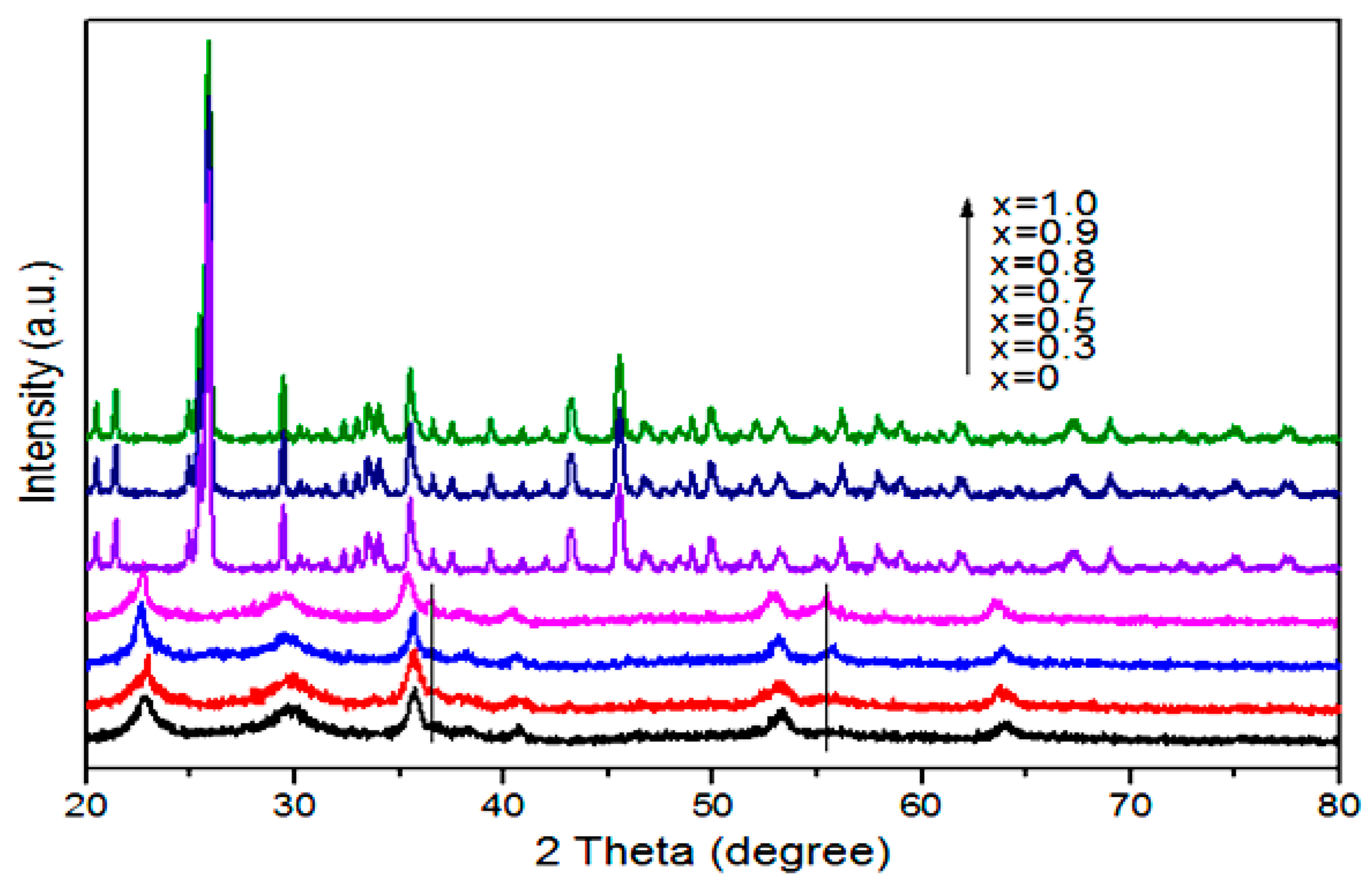
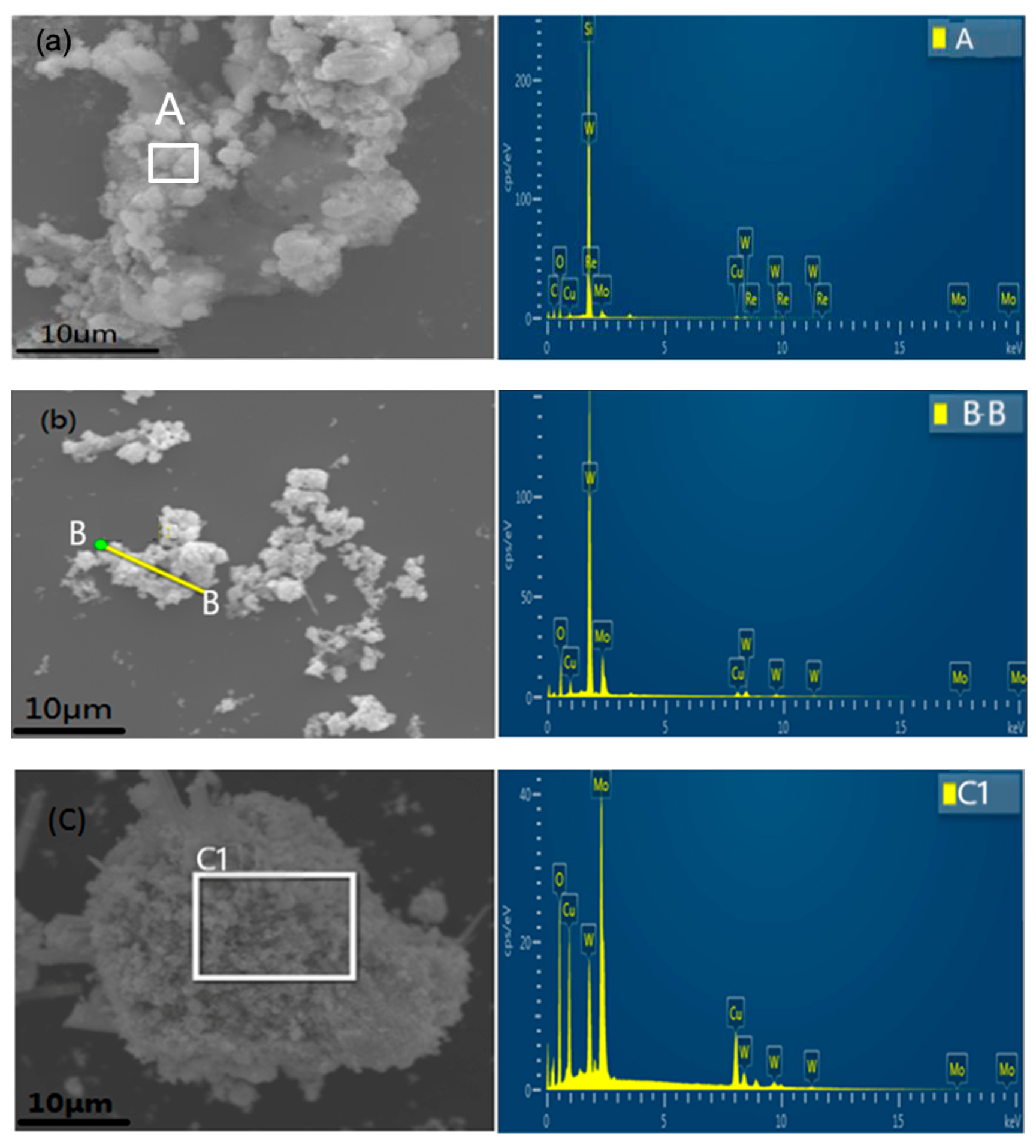

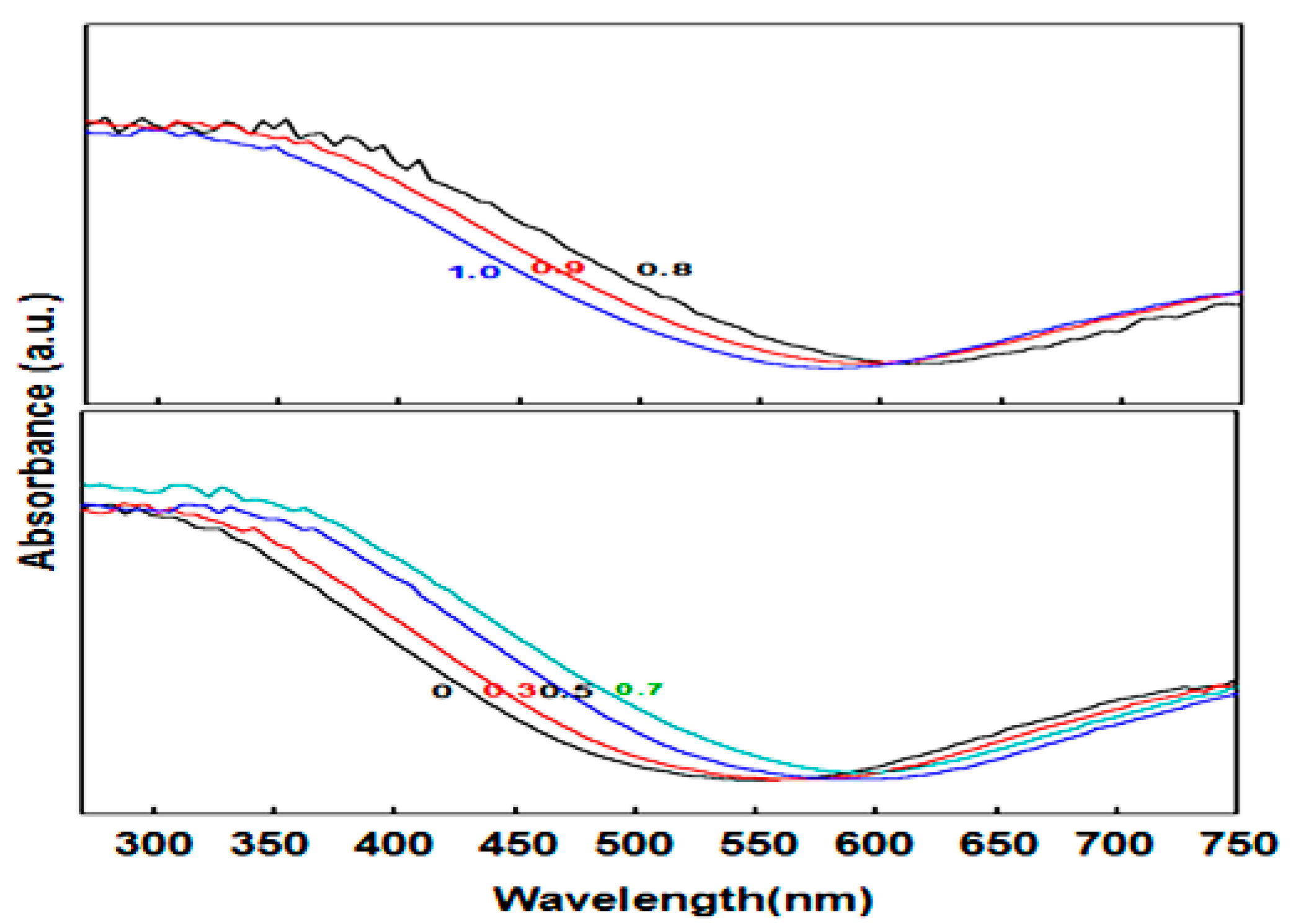

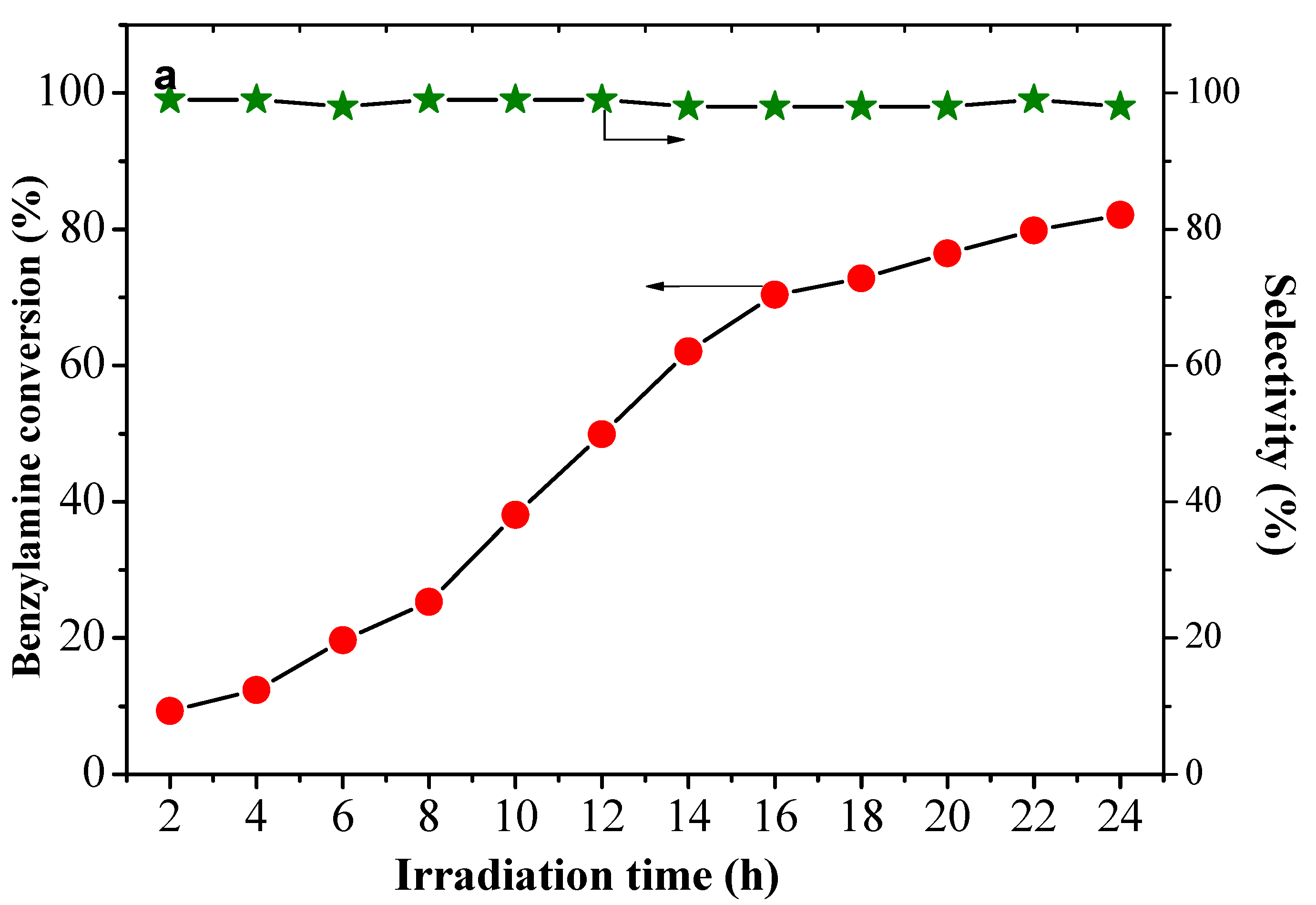
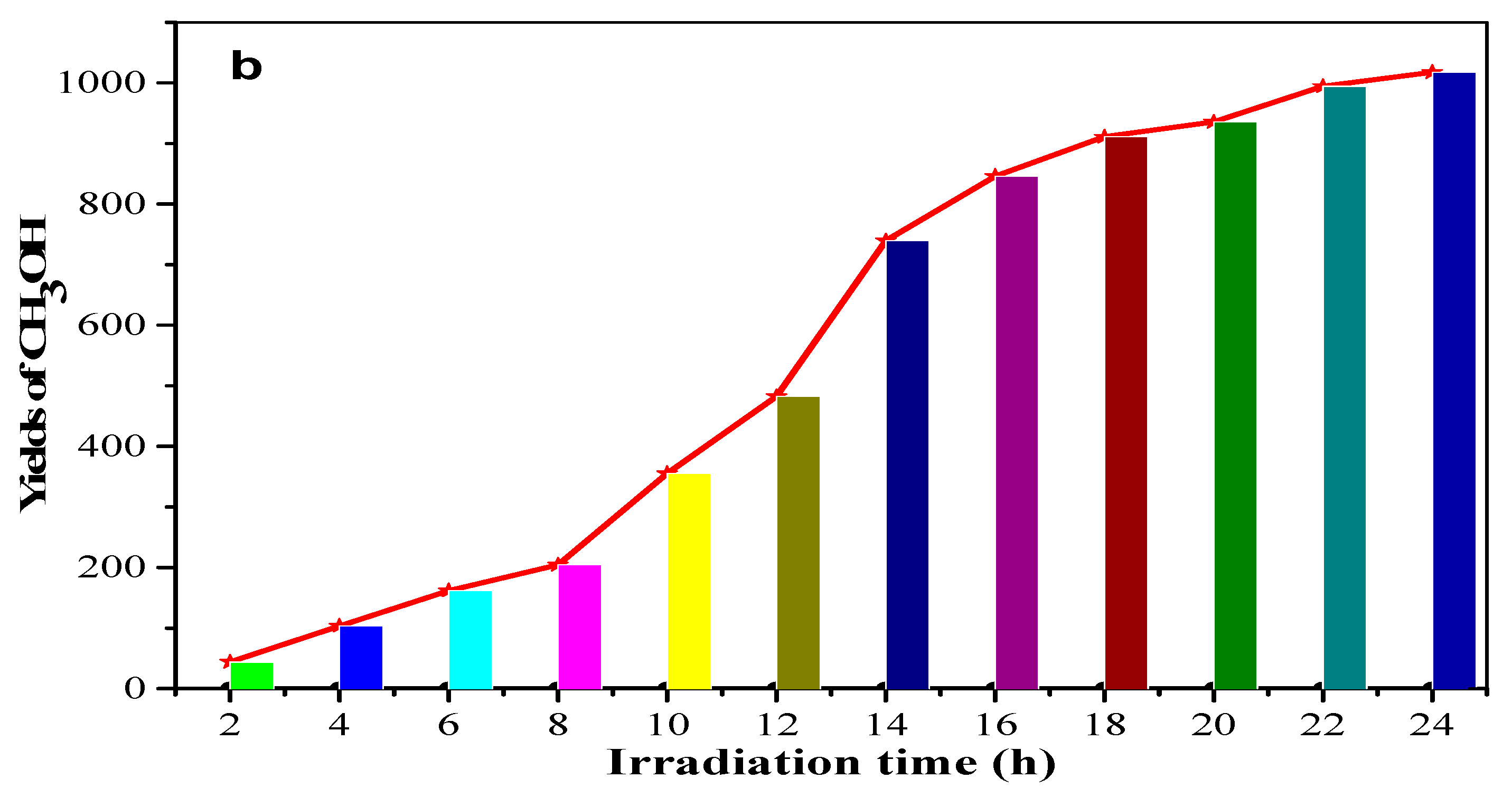

| Entry | The Value of x | The Ratio of Cu:Mo:W |
|---|---|---|
| 1 | 0.5 | 1:0.12:0.97 |
| 2 | 0.7 | 1:0.23:1.05 |
| 3 | 0.8 | 1:0.76:0.13 |
| Entry | Catalyst | Gas | CH3OH | Amine | Imine |
|---|---|---|---|---|---|
| the Value of x | (μmol/g) | Conv. (%) | Sel. (%) | ||
| 1 | 0 | CO2 | 296.9 | 29.5 | >99 |
| 2 | 0.3 | CO2 | 375.4 | 35.9 | >99 |
| 3 | 0.5 | CO2 | 571.2 | 48.3 | >99 |
| 4 | 0.7 | CO2 | 671.8 | 54.2 | >99 |
| 5 | 0.8 | CO2 | 509.9 | 45.7 | >97 |
| 6 | 0.9 | CO2 | 394.6 | 34.4 | >99 |
| 7 | 1.0 | CO2 | 249.3 | 23.1 | >99 |
| 8 a | 0.7 | N2 | -- | 2.1 | -- |
| 9 b | -- | CO2 | -- | 1.7 | -- |
| 10 c | 0.7 | CO2 | 51.7 | 9.5 | >99 |
| 11 d | 0.7 | CO2 | -- | -- | -- |
| 12 e | 0.7 | CO2 | -- | 91.3 | -- |
| 13 f | -- | CO2 | -- | 7.1 | -- |
| Entry | Reactant | Product | Yield b | Conv. (%) c | Sel. (%) d |
|---|---|---|---|---|---|
| 1 |  |  | 671.8 | 57.2 | 99 |
| 2 |  |  | 127.5 | 16.3 | 99 |
| 3 |  |  | 227.4 | 26.2 | 98 |
| 4 |  |  | 251.9 | 43.9 | 99 |
| 5 |  |  | 33.1 | 6.5 | 98 |
| 6 |  |  | 137.2 | 19.4 | 98 |
| 7 |  |  | 214.6 | 25.1 | 99 |
| 8 |  |  | 221.4 | 30.6 | 99 |
| 9 |  |  | 126.2 | 16.3 | 98 |
| 10 |  |  | 29.7 | 4.9 | 98 |
| 11 |  | -- | -- | -- | -- |
| 12 |  | -- | -- | -- | -- |
© 2020 by the authors. Licensee MDPI, Basel, Switzerland. This article is an open access article distributed under the terms and conditions of the Creative Commons Attribution (CC BY) license (http://creativecommons.org/licenses/by/4.0/).
Share and Cite
Luo, C.; Yang, T.; Huang, Q.; Liu, X.; Ling, H.; Zhu, Y.; Xia, G.; Zou, W.; Wang, H. CuMoxW(1-x)O4 Solid Solution Display Visible Light Photoreduction of CO2 to CH3OH Coupling with Oxidation of Amine to Imine. Nanomaterials 2020, 10, 1303. https://doi.org/10.3390/nano10071303
Luo C, Yang T, Huang Q, Liu X, Ling H, Zhu Y, Xia G, Zou W, Wang H. CuMoxW(1-x)O4 Solid Solution Display Visible Light Photoreduction of CO2 to CH3OH Coupling with Oxidation of Amine to Imine. Nanomaterials. 2020; 10(7):1303. https://doi.org/10.3390/nano10071303
Chicago/Turabian StyleLuo, Chao, Tian Yang, Qianfei Huang, Xian Liu, Huan Ling, Yuxin Zhu, Guoming Xia, Wennan Zou, and Hongming Wang. 2020. "CuMoxW(1-x)O4 Solid Solution Display Visible Light Photoreduction of CO2 to CH3OH Coupling with Oxidation of Amine to Imine" Nanomaterials 10, no. 7: 1303. https://doi.org/10.3390/nano10071303
APA StyleLuo, C., Yang, T., Huang, Q., Liu, X., Ling, H., Zhu, Y., Xia, G., Zou, W., & Wang, H. (2020). CuMoxW(1-x)O4 Solid Solution Display Visible Light Photoreduction of CO2 to CH3OH Coupling with Oxidation of Amine to Imine. Nanomaterials, 10(7), 1303. https://doi.org/10.3390/nano10071303



